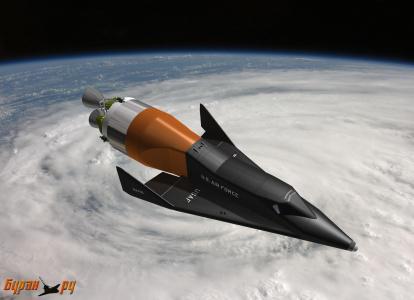
The current space is quite a peace. Joint ISS crews, unarmed spacecraft. But could have turned out the other way. On different space weapons, from personal weapons to space battleships this post.
Personal weapons h4>
TM h5>
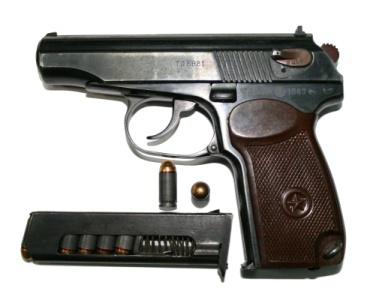
April 12, 1961, together with Gagarin went into space conventional Makarov pistol - as part of portable emergency (NAE). The idea is quite logical - in case of emergency landing, it could have come from the south of Greenland to the extreme northern point of Antarctica, and the need to shoot from the wolves, bears or tigers could easily arise. PM was part of the NAE before 1986, applications for its intended purpose is not fixed.
TP-82 h5>

In 1965, the "Voskhod-2" with the astronauts Belyaev and Leonov abnormally landed in snow-covered taiga Perm region, 75 km from the nearest town. Glades was not close, helicopters could not sit down, so Belyaev and Leonov spent three days in the winter forest. With helicopters dumped them warm clothes, on the second day came rescuers, but, in any case, the experience was not pleasant. On the Internet, go to stories about wolves / bears, which the astronauts had to drive away, but I think it's stories - sources directly involved in those events (Chertok, Kamanin), do not write about it (a real danger to life would be an emergency, that would have been recorded). Nevertheless, it is considered Leonov initiated the creation of a special weapon for the survival of astronauts. In 1979, while visiting an arms factory in Tula, he expressed a wish to have a special multi-purpose weapon. Armorers interested in the idea, and they made a combined triple-gun TP-82 with two smooth barrels caliber 32 (12, 5h70) and rifled a special 5 45h40. Weapon was developed three types of ammunition: the shot and the signal for 32 caliber bullet and 5, 45h40. TP-82 was part of the NAE from 1986 to 2006. By 2006, the cartridges are out of warranty, and make new nor desire any special sense was not. For almost fifty years of manned spaceflight need to use weapons have arisen.
For more information on TP-82 can почитать here .
Edged Weapons h5>

The American astronauts in a set of survival was nothing to shoot. Astronauts "Mercury" were knives Astro-17 , made by a small company on spec. order. In the survival kit "Apollo" is a machete:

Since 2006, and Russian cosmonauts have only edged weapons in the survival kit knife and machete, and signal cartridges for TP-82 was replaced with flares.
Chemical weapons h5>

Astronauts "Mercury" capsule splashed down cleanly, so part of the equipment included "chemical weapons" - shark repellent.
More information about American equipment can почитать here .
Laser weapons h5>

The idea of creating a military space stations (about them later) led to the logical question - what if a potential enemy arrives, look, yes knock us out of anything or take on board the ship and carry off to his country to learn our secrets? It was necessary to equip military astronauts. In 1984 he began a project to develop weapons of war for astronauts. But technological advances have led to the idea to create a laser pistol. The design was very interesting. As the "bullets" were used disposable chemical flashbulbs. Composition of zirconium foil and oxygen give flashes three times more powerful than conventional compositions based on magnesium, a part of the lamp metal salts "customized" by flash range absorption spectrum of the active element. The very active element, too, was quite unusual for the time - it was a волоконный laser . Flashbulbs were in the classical repertoire into eight "rounds". To light the lamp used an electric discharge, for which the gun was the standard devyativoltovaya "Crone". It is alleged that the laser beam retains its blinding and scorching action at a distance of 20 meters. Theoretically, the gun could be used against the people and against the optical systems engineering. In addition to the standard pistol on the same principles have been developed revolver and "ladies" single-shot pistol:
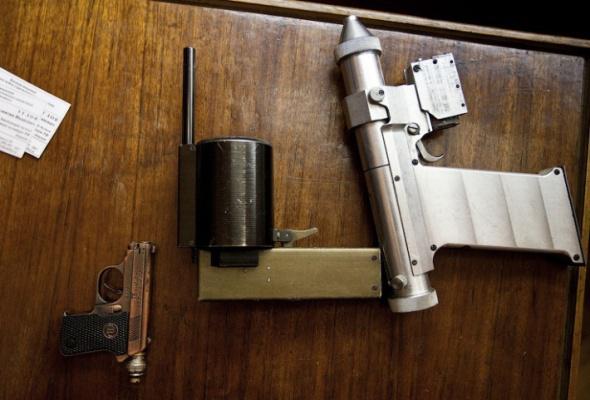
Conversion and subsequent collapse of the USSR put an end to the further development and the gun is now a museum exhibit and a monument to science and technology.
More information can be почитать here .
military space station h4>
MOL h5>

Historically, the first idea of military space stations decided to implement the Americans. By 1963 it was known that a person can stay in space for several days without any problems. Accordingly, the idea of creating manned reconnaissance station, the crew of which could in theory work better, more flexible and efficient than unmanned reconnaissance satellites. Manned Orbiting Laboratory (Manned Orbiting Laboratory, MOL) weighing 14 tons had to be in orbit up to 40 days with a crew of two people. The station was to be used for photographic reconnaissance, also proposed the idea of "inspection" of enemy satellites (although I can hardly imagine how they would do it - to change the orbit chetyrnadtsatitonnoy station needed to powerful engines, which are not in the illustrations, and run on one station to satellite would be too expensive). No weapons at the station set is not intended. After completing the mission, the crew took place in the modified ship "Gemini", which was launched together with monoblock station, undock and return to Earth.
MOL on the project took one unmanned flight OPS 0855 , which tested an unknown number of plant equipment and the modified heat shield "Gemini", with hatch to move to the station. In 1969, the project was canceled because it was gained experience in operating unmanned reconnaissance satellites and manned station did not look so attractive.
Diamond h5>

Publicly announced by US plans to build a MOL caused interest in military space stations in the USSR. KB Chelomeya was to develop the project stations "Diamond" for similar problems - mainly photographic reconnaissance. Station "Almaz" were displayed "Proton", so there was a big weight - 19 tons, can be (and are) in orbit for months. The crew flew to them on a separate "union" or «ТКС», so at one station could work consistently several crews. Station equipment was serious enough and is, basically, photo equipment:
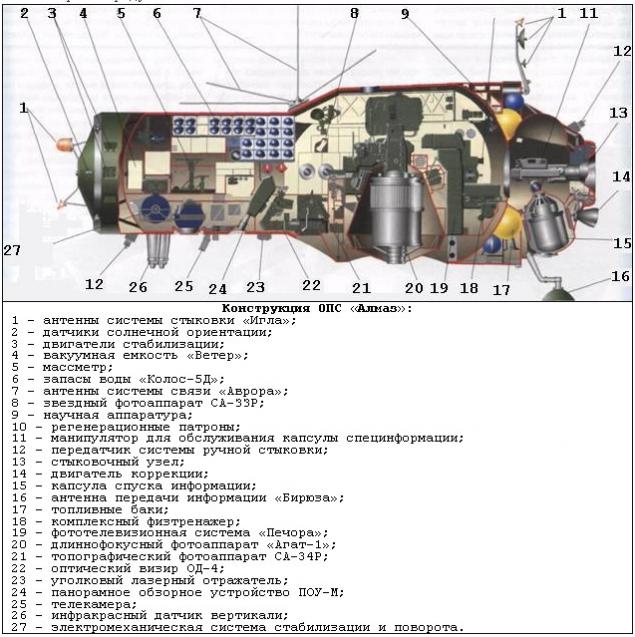
The most interesting is not shown. "Diamond" was the only really existed spaceship with weapons. According to the project at the stations of the first stage was to be automatic aircraft gun HP-23 for self-defense (Effective range 300 m) from intruders:

And at the station OPS-2, it "Salyut-3", it really was, and even shoot! Shortly before the end of the station when flying unmanned gun successfully tested. At the stations of the second phase were to be two missiles "space-space", and on the Internet, even claimed that they were at the station OPS-3 "Salyut-5", but I very much doubt it. Such a project would necessarily left behind documents (design, manufacturing, testing, mock-ups, and instructions on the use of simulators) and witnesses. A lack of such information suggests that the project is not further gone.
Due to the complex processes of convergence of military and civilian plants, "Diamonds" were identified as civilians "Salute" and run mixed up with them. In the 80s they flew and completely without crew, photo-reconnaissance satellites as large. Practice has shown that the for photography, radio and other intelligence are better suited drones.
module "Spectrum" station "Mir» h5>

Initially, the module "Spectrum" was created for military research program of space exploration and missile defense. His main tool would be the telescope "Peony" and gateways to launch artificial goals for calibration of the telescope. However, according to other sources, it would have to run full interceptor missiles are, unfortunately, there is some confusion in the sources. In any case, the military program was stopped, and the unit flew in 1995 in the form of civil heavily reworked, with an added American equipment.
Fighters satellites h4>
The fact that over your country with impunity flying alien spy satellites has created a natural desire to be able to these satellites posbivat. Such systems have been created quite a lot, so they are grouped by country.
US h5>
Bold Orion h6>
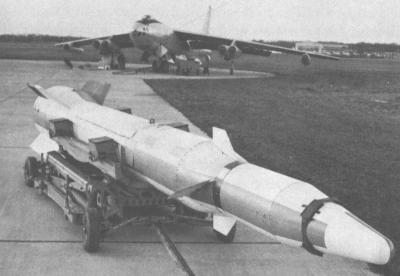
Anti-missile air-launched. October 13, 1959 the first and only test took place at 6, 4 km from the satellite Explorer 6, which would be enough to destroy a satellite in the case of a nuclear warhead.
High Virgo h6>

Anti-missile air-launched. The first and only test 22 September 1959 were unsuccessful.
DM-15S, Program 437 h6>

Modifications land- start (air defense missiles Nike-Zeus , and IDB Thor ) with very powerful warheads. Their undermining in space caused a powerful electromagnetic pulse, incapacitating all satellites in a large radius. Unit amount of missiles stood on alert.
ASM-135 ASAT h6>

In 1982, the United States were surprised to discover that the Soviet Union has its own anti-satellite system. Therefore urgently system was developed ASM-135. Air missile launch, the carrier is a fighter F-15. Defeat the purpose of going on a direct hit. The first test - January 21, 1984, the first successful destruction of the satellite - September 13, 1985. It is alleged that produced 15 missiles, the program closed in 1988.
RIM-161 Standard Missile 3 h6>

Ship-based missile to destroy satellites and ballistic missile combat units. The first test launch - in 2001, the first successful destruction of the satellite - February 21, 2008. Defeat the purpose of going on a direct hit. Produced more than a hundred rockets, is on alert.
Interesting video tests kinetic striking element // www.youtube.com/embed/W1HCFM9yoKo?wmode=opaque video>
USSR h5>
IP, IP-MU h6>

Anti-satellite to be launched into orbit on a normal pH ("Flight", "Cyclone"). The first flight of October 27, 1967 - "Cosmos-185". Last Flight - June 18, 1982 - "Kosmos-1379". Defeat the purpose of going to undermine the fragmentation warhead close to the target. The satellite has its own motor and can maneuver. The system was in service until the end of allegedly 1980s.
More details - here , here and here .
IP-MD "Along» h6>
Draft anti-satellite with the ability to defeat any purpose until the geostationary orbit on the basis of "IP-ME." Carrier - RN "Cyclone". Development started in 1988, stopped, presumably in 1993. Source .
Contact h6>

Draft anti-satellite missile air-launched. Carrier - the MiG-31. Development started probably in 1983, discontinued, presumably, in the 90s. Source .
Present h6>
Presumably, at the moment Russia does not have anti-satellite weapons. However, given the high secrecy surrounding such projects, it is difficult to say anything for sure.
China h5>
SC-19 h6>
January 11, 2007, China has brought down its satellite ground-based anti-satellite missile. The missile was placed on a mobile chassis. The principle of destruction - a direct hit. Due to the secrecy of the details are unknown.
Satellites missile defense h4>
SDI h5>
Strategic Defense Initiative (SDI) - is one of the symbols of the militarization of space. The program is literally cosmic scale included the creation of layered missile defense, consisting of:
Tracking and targeting. B>
Terrestrial interceptors (Extended Range Interceptor (ERINT), Homing Overlay Experiment (HOE), Exoatmospheric Reentry-vehicle Interceptor Subsystem (ERIS), rose from the last system Terminal High Altitude Area Defense (THAAD)).

The rocket THAAD, spiral - a solid fuel burning excess. I>
Space Systems Atomic buckshot abbr>, railgun, kinetic interceptors" brilliant pebbles ».
Slides '' brilliant pebbles '' 


An interesting film in English // www.youtube.com/embed/yDCzpAuWM1w?wmode=opaque video>
However, almost all systems were only in pictures. Most promising system was considered "brilliant pebbles" because of its relative simplicity, but it has not been deployed. SDI program officially closed in 1994.
The Soviet response h5>
USSR did not stay away from the high-tech military space. Projects were created "Skif" with laser weapons and "Cascade" rocket. Skiff:

Layout "Scythian" control system, but without arms, was launched at the first launch of "Energy" under the name "Pole».
Cascade:

More details can be read here or here .
Warships h4>
Military «Unions» h5>
Parallel civil "Union" is developing a set of different military modifications:

From left to right: "Soyuz-U", "Soyuz-PEP", "Soyuz-P", "Soyuz-VI", "Soyuz-VI / OIF» i>
Soyuz-U "Interceptor". Project 1963. Intended for "inspection" of enemy satellites. One of the cosmonauts (crew two people) had to go out into space and see the enemy satellites. Then, the satellite could be destroyed, neutralize or steal. The project has not been worked out in detail, his armor is unknown. «Soyuz-PPK": "manned interceptor." Project 1964. The project worked out a rather risky spacewalk ship was eight short-range missiles that could destroy enemy satellites from a safe distance. «Soyuz-P", "spy". Project 1963. Scout ship in two parts, the joints in orbit - the usual "Union" and the intelligence unit, which later grew photo-reconnaissance satellites "Amber» «Soyuz VI": "military research." Intelligence modification to the arrangement of compartments like MOL (lander front) and radioisotope generator as an energy source. «Soyuz-VI / OIC." Modification of the "Union-VI" after the death of Korolev Vasily Mishin. RTGs have been removed, but was added to the second module similar to "Soyuz-P». Source 1 , Source 2 , Source 3 , Source 4 , Source 5 .
Military "Apollo» h5>
There was the idea that the "Apollo" in a warship for the same purposes - satellites inspection and, if necessary, destruction. Curiously, for the destruction proposed to use a hand-manipulator, not the gun / missile. Large supply of characteristic velocity "Apollo" made this modification is very attractive. Source .
Cruiser Orion h5>

The most apocalyptic of all projects. However, it is realized in the presence of an astronomical amount of money. Atomic-pulse space cruiser "Orion". The project is the beginning of the 1960s. He «Deep Space Bombardment Force». Mass probably exceed 10,000 tons. Armament:
href="https://plus.google.com/events/cskam4rego7144abe1c2ddmh34o">https://plus.google.com/events/cskam4rego7144abe1c2ddmh34o





























